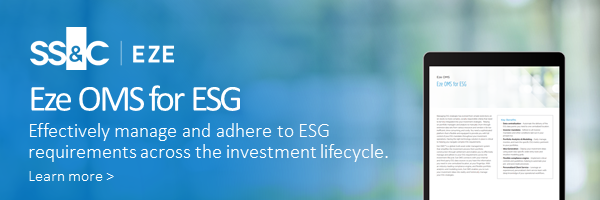Amidst the volatility the last year has brought to the market, ESG investing has presented itself as one of the fastest-growing asset management trends. A changing world and investment landscape demands active strategies that adapt quickly, to satisfy investor demands. We think ESG, no matter the size and scale of your operations, will be difficult to ignore in the years ahead.
ESG is here to stay
Between 2016 and 2018, responsible investing assets have risen from $22 trillion to over $30 trillion, a 34% increase in just two years. Within that overarching statistic, AUM for ESG specific integrations has grown 70% to over $17 trillion in that same 2-year span. Changing demographics, an increasingly competitive landscape, deeper insight into companies’ social responsibility strategy, and better access to pertinent data have led to a growing affinity for ESG conscious companies.
With sustainable investing on the rise and a growing percentage of funds using ESG in their investment process, leveraging ESG data into your portfolios provides a fantastic opportunity to attract new investors, satisfy current investors’ changing mandates, and get ahead of investor demands.
Going beyond just gathering the data
The biggest challenge you may face incorporating ESG principles is synthesizing the vast amount of data into an efficient process. Simply refraining from investing in certain stocks, based on basic company knowledge, is no longer sufficient in evaluating which companies meet your ‘ESG’ criteria. Relying on portfolio managers and analysts to churn through extensive data sets from various resources and vendors to devise proper weightings is far too inefficient, time-consuming, and costly.
Leverage technology to mine through and unify data
The best way to alleviate these challenges is to integrate whichever ESG data you choose to use into your order management system. Your OMS should centralize all data, third-party or internal - allowing you to automate data unification, so you can focus on producing results while satisfying your investor requirements. There are numerous data providers that publish ESG ratings, metrics, and various other data points that can be delivered daily, and your system needs to be able to connect to your ESG third-parties and load this data consistently and seamlessly. Having a system that leverages an open, vendor neutral architecture that enables you to connect with any data source can dramatically speed up ESG implementation.
We’ve seen firsthand how having the right technology in place has helped our clients seamlessly implement and manage their ESG strategies in Eze OMS, whether they are managing a single ESG fund or are applying ESG constraints across their universe of portfolios. Eze OMS enables our clients to adhere to their ESG requirements and principles across the investment lifecycle. It provides the flexible compliance and analytics and modeling functionality necessary to holistically manage their ESG strategies.
Monitoring the ESG metrics most relevant to your strategies
With the data at your fingertips, your system should provide flexibility to create simplified workflows and controls surrounding your ESG strategy. Modeling and analytics tools enable portfolio managers to monitor, manage, and track specific ESG metrics that are relevant for their portfolios. For example, if a certain portfolio’s revenue exposure to alcohol production shouldn’t be above a certain threshold, you should be able to easily monitor and rebalance your portfolio to abide by this directive. A combination of ESG data feeds and powerful modeling and analytics tools unlock the ability to keep your investments within your strategy’s principles and your client’s mandates.
Putting compliance at the forefront gives you holistic control
A flexible compliance engine enables you to harness ESG data and implement critical controls and guidelines, helping to automate your pre- and post-trade processes. On top of restricting specific securities, tracking and comparing benchmarks and performing complex calculations within a portfolio should be simple and integrated with your compliance engine. Creating compliance rules and guidelines based on all of your data, including ESG data integrations, should automate typically manual workflows and remove manager discretion risk, allowing your portfolio managers to concentrate on alpha generating tasks.
What does this mean for ESG moving forward?
ESG investing may have once appeared to be a passing fad, but a developing macro environment, changing demographics, and increasing access to data shows that this trend will continue to grow in coming years. Although we have seen some fund managers be slower to adopt ESG, pressure from investors may ultimately push funds to adapt and rethink their current strategies, likely implementing certain ESG principles. You may find yourself onboarding numerous ESG data providers, but mining that disparate data manually is especially inefficient. ESG principles, metrics, and rules can be easily woven into your investment process, and automation is key to not burden managers with unnecessary manual workflows. Partnering with the right technology vendor who knows your business, has the experience implementing various ESG principles and centralizing your internal and third-party data, and puts compliance at the forefront, will undoubtedly make a transition to ESG seamless. We see this as a great opportunity for managers to stay competitive as the industry adapts to this growing trend.
If you’re looking to stay competitive by incorporating ESG factors into your investment criteria, check out Eze OMS for ESG:


